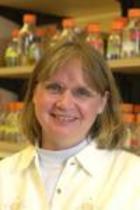G. Shirleen Roeder
Eugene Higgins Professor of Molecular, Cellular and Developmental Biology, Professor of Genetics
 Shirleen Roeder, B.Sc., Dalhousie University, Ph.D., University of Toronto, faculty member at Yale since 1981: With a tiny virus called “bacteriophage T7”, you began your quest to unlock the secrets of how DNA begets more DNA, and how virus genes recombine to rewrite their genetic codes. Could you—or anyone—have foreseen that these tiny molecular devices and their tiny molecular gears would launch the career of a spectacular geneticist?
Shirleen Roeder, B.Sc., Dalhousie University, Ph.D., University of Toronto, faculty member at Yale since 1981: With a tiny virus called “bacteriophage T7”, you began your quest to unlock the secrets of how DNA begets more DNA, and how virus genes recombine to rewrite their genetic codes. Could you—or anyone—have foreseen that these tiny molecular devices and their tiny molecular gears would launch the career of a spectacular geneticist?
While many scientists only thought of DNA as the stable storehouse for life’s blueprints, you gravitated to solving the mysteries regarding how some genes jump around and cause genetic chaos. Your fascinating studies on these selfish DNA sequences called transposons eventually led you to uncover secrets of how the genes we get from our parents can be shuffled to create new combinations that we then pass on to our children.
At Cornell and eventually at Yale, yeast became your object of study. Of course, most people who use yeast are making bread or fermenting beverages, but you peered into its microscopic insides to reveal the amazing machinery of chromosome instability and separation. Your team discovered the protein Zip1, which began the flood of discoveries by you and by others of proteins that bind similar chromosomes together. Once bound, these chromosomes furiously trade genes before being pulled apart to each reside in a newly-divided cell.
Yet during this time of intense research and discovery, your service to the University never wavered. Our biology majors and premed students learned of the amazing mechanisms of heredity in your genetics lectures, and your most recent role as a leader of our largest graduate student training program in biology helped students and faculty from all parts of campus become a more unified community of scholars. Your wonderful genetic discoveries earned you the prestigious position of Investigator with the Howard Hughes Medical Institute and election to the US National Academy of Sciences.
But there is more! For it turns out you are the owner and trainer of a breed of dog known as the Flat-Coated Retriever, and that the same year you were inducted into the National Academy your second dog was inducted into the Flat-Coated Retriever Hall of Fame on the basis on excellence in agility and field training. No doubt you are likely the only National Academy member who owns a Zinger Winger—a slingshot for hurling dead ducks—or who stores in her refrigerator frozen pheasants, pigeons, and ducks for training her beloved dogs.
Although your dog training activities have helped strike a balance with your academic career, you learned all too painfully that Fat-Coated Retrievers are prone to devastating cancers and seldom live more than eight years. Dr. Roeder, the scientist, went to work for this cause, promoting research and gathering blood and tissue samples to help researchers find markers for the genes that make the breed vulnerable.
Scientist, teacher, dog trainer—a person who undertakes everything with wholehearted energy—as you retire your Yale colleagues salute you for your capacities and offer you an Eli Bow-Wow.
Tribute Editor: Penelope Laurans